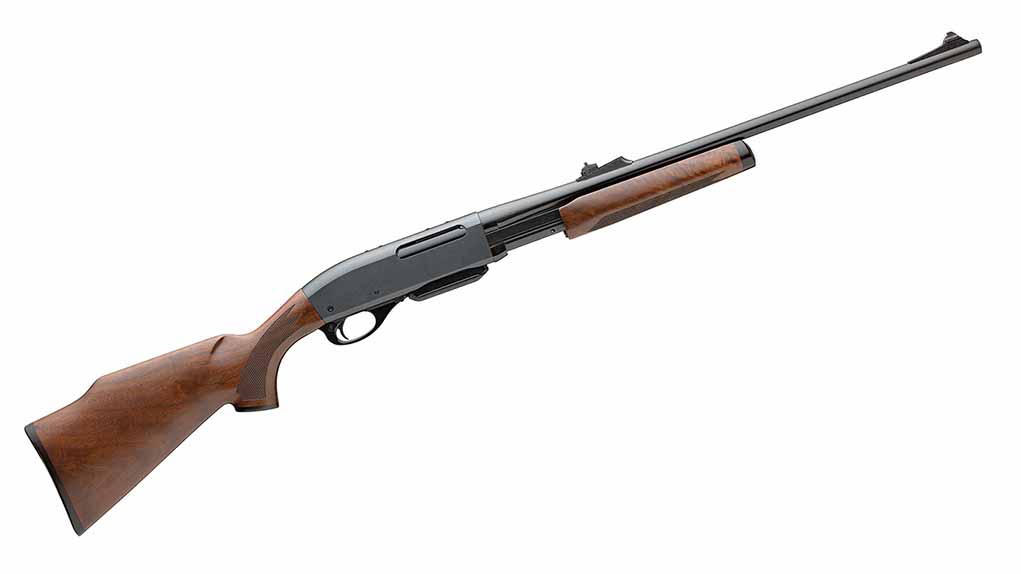
The Remington Model 760 was exceptionally accurate and fast shooting, but was far from the first pump-action gem “Big Green” turned out.
What Are The Advantages Of The Pump-Action Rifle:
- Among the fastest manually operated actions.
- Inherently, the pump is ambidextrous.
- The rifle can use loads semi-autos would fail to cycle.
- Certain designs have proven exceptionally accurate.
The slide-action, or pump, firearm has often been described as uniquely American. While the first patent for the design was issued in the 1850s in England, pump guns—both shotguns and rifles—never really caught on in the United Kingdom or Europe. Many shooters “across the pond” look upon them with disdain, as do some in the United States. Yet, others swear by them.
The pump has many advantages: It’s the fastest and easiest to use of the manually operated actions; it’s ambidextrous (although empty cases are ejected into the lefty shooter’s field of view); and the operation gives the pump the ability to use ammo loads of varying power that a semi-auto would fail to cycle.
Slide-action fans have been compared to drivers who prefer a stick shift transmission. Some people just prefer a hands-on relationship with things. There are hunters who have nothing but slide-action shotguns, rimfires and centerfire rifles in their gun safes. If you like a pump, you like a pump.
Pump-Action Shotgun's Backstory
Remington has a long history with slide-actions. What was called the Remington Repeating Shotgun was introduced in 1908. Two years later, it was renamed the Model 10.
Remington pump shotgun designs evolved through the first half of the century. Several popular models were offered: the Model 17, 29 and the 31. Then, in 1950, the great Model 870 was announced. It is still in production, with more than 11 million sold, making it the most manufactured shotgun in firearms history.

Slide-action rifles became a part of Remington’s legacy in 1909 with the introduction of the Model 12 .22 rimfire. It evolved into the 121 in the 1930s and was replaced in the ‘50s by the 572, which is still in production today.
Remington Centerfire Pump-Actions
The focus of this month’s column is the Remington centerfire slide-action family of firearms.
More Gun Collecting Info:
- The Walther PP Series
- The Quintessential 22 Pistol: The Colt Woodsman
- The Rocky History Of The L.C. Smith
- The Browning SA-22
- Colt Python: The Cadillac Of Revolvers
Big Green’s history with this category of rifles goes back to the Model 14. It was introduced in 1912 and was chambered for three Remington rounds: the .25 Rem., .30 Rem. and .32 Rem.—all rimless versions of the .25-35, .30-30 and .32 Win. Special.
A variant, the 14½, was added in 1913 and was offered in the popular .38-40 and .44-40 Winchester calibers. The Model 14 and 14½ were in production until 1935, when they were replaced by the Model 141, which was made until 1950. The 141 was chambered for the same cartridges as the Model 14—.25 Rem., .30 Rem. and .32 Rem.—as well as the .35 Remington.
Another early Remington slide-action centerfire was the Model 25, in production from 1923 to 1936. It was offered in .25-20 and .32-20, two very popular small-game cartridges of the day.
In April 1952, Remington introduced the first slide-action rifle that was chambered for popular big-game cartridges such as the .30-06, .270 Win. and .300 Savage. This was the Model 760 Gamemaster. Other original chamberings included the .222 Rem., .244 Rem., .257 Roberts, .280 Rem., .35 Rem. and later, the .243, 6mm Rem. and .308 Winchester.

The Model 760 introduced several improvements over the 141, including dual-action bars and a detachable magazine that allowed the use of spitzer bullets. The standard model came with a 22-inch barrel, but there was also a carbine version with an 18½-inch barrel.
The slide-action Model 760 was an accurate rifle and was able to keep up with the famous bolt-action target guns. In 1961, a U.S. shooter won the double-shot aggregate at the World Championship in Oslo, Norway, with a 760, and another took second place in the single-shot World Championship in Cairo, Egypt. 1
The Model 760 remained in production until 1981, when it was replaced by the Model 7600. Over its 28-year run, 1,034,462 Model 760 Gamemasters were manufactured. This included several Deluxe and High Grade models, such as Remington’s Peerless and Premier grades, which featured extensive engraving. 2
Some of the rarer calibers are worth a considerable premium over standard chamberings.
FOOTNOTES
1: Pa Was a Pump Gun Man, 62nd Edition, Gerald Peterson, Gun Digest, 2008
2: The History of Remington Firearms, Roy Marcot, Chartwell Books, 2011
For more information on Remington pump-action guns, please visit remington.com.
The article originally appeared in the October 2019 issue of Gun Digest the Magazine.

Next Step: Get your FREE Printable Target Pack
Enhance your shooting precision with our 62 MOA Targets, perfect for rifles and handguns. Crafted in collaboration with Storm Tactical for accuracy and versatility.
Subscribe to the Gun Digest email newsletter and get your downloadable target pack sent straight to your inbox. Stay updated with the latest firearms info in the industry.

![Best Concealed Carry Guns In 2025 [Field Tested] Wilson Combat EDC X9S 1](https://gundigest.com/wp-content/uploads/Wilson-Combat-EDC-X9S-1-324x160.jpg)


![Best 9mm Carbine: Affordable PCCs [Tested] Ruger Carbine Shooting](https://gundigest.com/wp-content/uploads/Ruger-Carbine-Shooting-100x70.jpg)
![Best AR-15: Top Options Available Today [Field Tested] Harrington and Richardson PSA XM177E2 feature](https://gundigest.com/wp-content/uploads/Harrington-and-Richardson-PSA-XM177E2-feature-100x70.jpg)

You forgot the Winchester mod 12
Just wondering, I have a Remington #122848 760 savage pump 300. I am contiplating selling. Has a Weaver 3-10 scope. What would be a good offer?